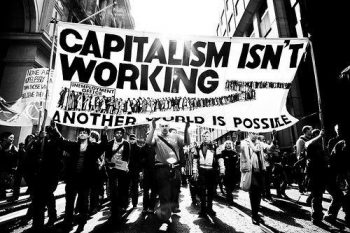By Paul Buchheit
Guest writer for Wake Up World
The “Jobs for Everyone” Fantasy
“The more robots we add to our fulfillment centers, the more jobs we are creating,” says Tye Brady, Amazon’s Chief Technologist. That’s just one outlandish example of the job-related hyperbole we’ve been subjected to recently. We keep hearing about the low unemployment rate and the “booming” economy. “Economic news has been staggeringly good,” said Jared Whitley, associate director in the White House under George W. Bush. More hype comes from CNN Money, which talks about “opportunities for almost everyone”; and the windy Wall Street Journal, which claims that “Americans traditionally left behind… are reaping the benefits.”
The super-capitalists want us to believe that they know what they’re talking about. Part of their strategy, based on a neoliberal disdain for any government efforts to provide opportunities for average people, is to perpetuate the myth, as Milton Friedman said, that “the free market system distributes the fruits of economic progress among all people.” Part of this myth is a job for everyone, or “full employment,” which many economists believe we have attained with an unemployment rate under 4 percent.
But “jobs for all” is a fantasy, if we’re talking about family-sustaining, living-wage jobs, as we should. The facts make that clear.
How is that Imaginary Unemployment Rate Determined?
The official unemployment rate, according to the Bureau of Labor Statistics (BLS) itself, is based on employees “who did any work for pay or profit during the survey reference week.” The BLS workforce includes contingent and alternative employment arrangements that make up about 10% of the workforce. It includes part-time workers (even one hour a week!), who make up about 16% of the workforce. And, inexplicably, it fails to count as unemployed those who have given up looking for work — 4% more Americans than in the year 2000.
Americans Haven’t Been Paid for Their Productivity
The Bureau of Labor Statistics and the Federal Reserve both report that worker productivity has grown much faster than wages in the past three decades (although productivity has declined since the recession). Some sources show virtually no growth in wages since the 1980s. Meanwhile, expenses have continued to climb beyond reach. Tuition is up 12 times, medical costs 6 times, food 2 to 3 times. Workers can’t cope with it all. Over three quarters of them admit to living paycheck to paycheck, often without their own living accommodations. A survey of 16 metropolitan areas found that median rent for Millennials is an astounding 68 percent of their incomes. More and more 25- to 29-year-olds are forced to live with their parents or grandparents, more than at any time in the past 75 years.
Business Insider provides a shocking summary of the realities facing today’s workers: “The last time unemployment was as low as its current rate, in 1975, earnings increased by 30% a year. Today, average wage growth is only 1.9%.”
There are Millions of Underpaid, No-Benefit Jobs
Reports of the gig economy have been strenuously challenged even by progressive writers. But the naysayers are missing the point. It doesn’t matter if the level of fulltime jobs has remained constant, if those jobs don’t pay a living wage, and if they don’t include retirement and health benefits. Even as the NY Times questions the existence of a gig economy, it admits that many companies outsource much of their business to subcontractors. A Princeton study found that 94% of new jobs created in a recent decade were temporary or contract-based, rather than traditional full-time positions. An NPR/Marist poll found that one of every five jobs in America is held by a contract worker. For those who do “gig only” work (rather than gig plus a traditional job), a Prudential survey found that their pay averages $36,500 per year, not much more than half the average full-time salary of $62,700. Many of our young adults are stuck in “gig only” work lives. Nearly half of college graduates up to age 27 work in jobs that don’t require a college degree.
In addition to the meager pay, most have no benefits, no job security, no government regulations backing them, and usually a longer work day, with many young people putting in 10- to 12-hour days for $13 per hour or less. The negative effects cross over into the once-stable workforce. Taxi drivers in New York, for example, saw their annual revenue drop over 20% in three years as the Uber and Lyft drivers moved in.
It could get even worse. The Department for Professional Employees estimates that nearly 10 million service industry jobs will be added in the next decade. These include millions of jobs in personal care and health care, which are of the utmost importance to society but are traditionally paid very little.
The Great Hypocrisy
Businesses say they can’t find skilled workers, implicitly blaming our educational system, but then they scrupulously avoid paying their taxes, and as a result education funding is constantly cut. Average Americans have few options for middle-income job training. But for the CEOs, soothing talk about a surging economy is a lot easier than actually investing in the country that made them rich.
Recommended reading by Paul Buchheit:
- Big Pharma, Big Oil and Big Banks – The Definition of Terrorism
- 5 Signs of a Dying Society
- Capitalism at Its Worst: 5 Deadly Sins of Big Pharma
- Facts That Our War-Happy Leaders Would Like to Keep Hushed Up
- How Wealth Inequality Kills
- Now Just FIVE Men Own Almost as Much Wealth as Half the World’s Population
- The Real Terrorists: The 0.01%
- A 2% Financial Wealth Tax Could Provide a $12,000 Annual Income to Every American Household
About the author:
 Paul Buchheit is a college teacher, an active member of US Uncut Chicago, founder and developer of social justice and educational websites (including www.youdeservefacts.org), and the editor and main author of “American Wars: Illusions and Realities” (Clarity Press). His latest book is, Disposable Americans: Extreme Capitalism and the Case for a Guaranteed Income. Paul can be reached via email here.
Paul Buchheit is a college teacher, an active member of US Uncut Chicago, founder and developer of social justice and educational websites (including www.youdeservefacts.org), and the editor and main author of “American Wars: Illusions and Realities” (Clarity Press). His latest book is, Disposable Americans: Extreme Capitalism and the Case for a Guaranteed Income. Paul can be reached via email here.
This work is first appeared on Common Dreams and is licensed under a Creative Commons Attribution-Share Alike 3.0 License.

If you've ever found value in our articles, we'd greatly appreciate your support by purchasing Mindful Meditation Techniques for Kids - A Practical Guide for Adults to Empower Kids with the Gift of Inner Peace and Resilience for Life.
In the spirit of mindfulness, we encourage you to choose the paperback version. Delve into its pages away from screen glare and notifications, allowing yourself to fully immerse in the transformative practices within. The physical book enriches the learning process and serves as a tangible commitment to mindfulness, easily shared among family and friends.
Over the past few years, Wake Up World has faced significant online censorship, impacting our financial ability to stay online. Instead of soliciting donations, we're exploring win-win solutions with our readers to remain financially viable. Moving into book publishing, we hope to secure ongoing funds to continue our mission. With over 8,500 articles published in the past 13 years, we are committed to keeping our content free and accessible to everyone, without resorting to a paywall.







